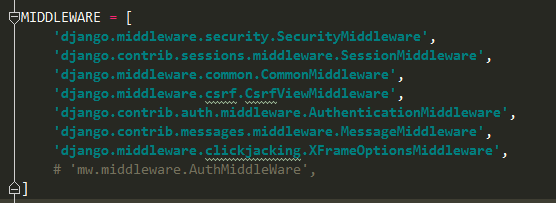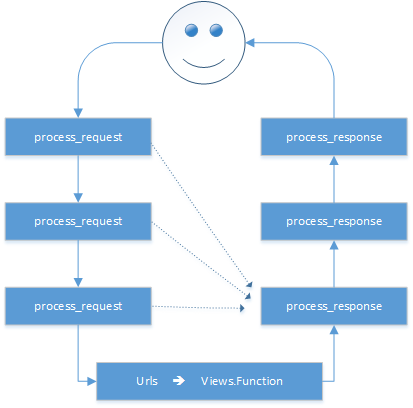py17day21
Django(4)
一,Django Form:
Django的Form主要具有以下几大功能:
- 生成HTML标签
- 验证用户数据(显示错误信息)
- HTML Form提交保留上次提交数据
- 初始化页面显示内容
1.基本用法:
a)创建Form类:
from django.forms import Form from django.forms import widgets from django.forms import fields class MyForm(Form):
#尽量和数据库字段名一致,会生成name=""的标签,方便后台接受POST过来的数据进行统一数据库操作 user = fields.CharField( widget=widgets.TextInput(attrs={'id': 'i1', 'class': 'c1'}) ) gender = fields.ChoiceField( choices=((1, '男'), (2, '女'),), initial=2, widget=widgets.RadioSelect ) city = fields.CharField( initial=2, widget=widgets.Select(choices=((1,'上海'),(2,'北京'),)) ) pwd = fields.CharField( widget=widgets.PasswordInput(attrs={'class': 'c1'}, render_value=True) )
b)View函数处理:
from django.shortcuts import render, redirect from .forms import MyForm def index(request): if request.method == "GET": obj = MyForm() return render(request, 'index.html', {'form': obj}) elif request.method == "POST": obj = MyForm(request.POST, request.FILES) if obj.is_valid(): values = obj.clean() print(values) else: errors = obj.errors print(errors) return render(request, 'index.html', {'form': obj}) else: return redirect('http://www.google.com')
3)生成HTML:
<form action="/" method="POST" enctype="multipart/form-data"> <p>{{ form.user }} {{ form.user.errors }}</p> <p>{{ form.gender }} {{ form.gender.errors }}</p> <p>{{ form.city }} {{ form.city.errors }}</p> <p>{{ form.pwd }} {{ form.pwd.errors }}</p> <input type="submit"/> </form>

<form method="POST" enctype="multipart/form-data"> {% csrf_token %} {{ form.xxoo.label }} {{ form.xxoo.id_for_label }} {{ form.xxoo.label_tag }} {{ form.xxoo.errors }} <p>{{ form.user }} {{ form.user.errors }}</p> <input type="submit" /> </form>
2.Form类:
创建Form类时,主要涉及到 【字段】 和 【插件】,字段用于对用户请求数据的验证,插件用于自动生成HTML;
a)Django内置字段如下:

Field required=True, 是否允许为空 widget=None, HTML插件 label=None, 用于生成Label标签或显示内容 initial=None, 初始值 help_text='', 帮助信息(在标签旁边显示) error_messages=None, 错误信息 {'required': '不能为空', 'invalid': '格式错误'} show_hidden_initial=False, 是否在当前插件后面再加一个隐藏的且具有默认值的插件(可用于检验两次输入是否一直) validators=[], 自定义验证规则 localize=False, 是否支持本地化 disabled=False, 是否可以编辑 label_suffix=None Label内容后缀 CharField(Field) max_length=None, 最大长度 min_length=None, 最小长度 strip=True 是否移除用户输入空白 IntegerField(Field) max_value=None, 最大值 min_value=None, 最小值 FloatField(IntegerField) ... DecimalField(IntegerField) max_value=None, 最大值 min_value=None, 最小值 max_digits=None, 总长度 decimal_places=None, 小数位长度 BaseTemporalField(Field) input_formats=None 时间格式化 DateField(BaseTemporalField) 格式:2015-09-01 TimeField(BaseTemporalField) 格式:11:12 DateTimeField(BaseTemporalField)格式:2015-09-01 11:12 DurationField(Field) 时间间隔:%d %H:%M:%S.%f ... RegexField(CharField) regex, 自定制正则表达式 max_length=None, 最大长度 min_length=None, 最小长度 error_message=None, 忽略,错误信息使用 error_messages={'invalid': '...'} EmailField(CharField) ... FileField(Field) allow_empty_file=False 是否允许空文件 ImageField(FileField) ... 注:需要PIL模块,pip3 install Pillow 以上两个字典使用时,需要注意两点: - form表单中 enctype="multipart/form-data" - view函数中 obj = MyForm(request.POST, request.FILES) URLField(Field) ... BooleanField(Field) ... NullBooleanField(BooleanField) ... ChoiceField(Field) ... choices=(), 选项,如:choices = ((0,'上海'),(1,'北京'),) required=True, 是否必填 widget=None, 插件,默认select插件 label=None, Label内容 initial=None, 初始值 help_text='', 帮助提示 ModelChoiceField(ChoiceField) ... django.forms.models.ModelChoiceField queryset, # 查询数据库中的数据 empty_label="---------", # 默认空显示内容 to_field_name=None, # HTML中value的值对应的字段 limit_choices_to=None # ModelForm中对queryset二次筛选 ModelMultipleChoiceField(ModelChoiceField) ... django.forms.models.ModelMultipleChoiceField TypedChoiceField(ChoiceField) coerce = lambda val: val 对选中的值进行一次转换 empty_value= '' 空值的默认值 MultipleChoiceField(ChoiceField) ... TypedMultipleChoiceField(MultipleChoiceField) coerce = lambda val: val 对选中的每一个值进行一次转换 empty_value= '' 空值的默认值 ComboField(Field) fields=() 使用多个验证,如下:即验证最大长度20,又验证邮箱格式 fields.ComboField(fields=[fields.CharField(max_length=20), fields.EmailField(),]) MultiValueField(Field) PS: 抽象类,子类中可以实现聚合多个字典去匹配一个值,要配合MultiWidget使用 SplitDateTimeField(MultiValueField) input_date_formats=None, 格式列表:['%Y--%m--%d', '%m%d/%Y', '%m/%d/%y'] input_time_formats=None 格式列表:['%H:%M:%S', '%H:%M:%S.%f', '%H:%M'] FilePathField(ChoiceField) 文件选项,目录下文件显示在页面中 path, 文件夹路径 match=None, 正则匹配 recursive=False, 递归下面的文件夹 allow_files=True, 允许文件 allow_folders=False, 允许文件夹 required=True, widget=None, label=None, initial=None, help_text='' GenericIPAddressField protocol='both', both,ipv4,ipv6支持的IP格式 unpack_ipv4=False 解析ipv4地址,如果是::ffff:192.0.2.1时候,可解析为192.0.2.1, PS:protocol必须为both才能启用 SlugField(CharField) 数字,字母,下划线,减号(连字符) ... UUIDField(CharField) uuid类型 ...
注:UUID是根据MAC以及当前时间等创建的不重复的随机字符串
>>> import uuid # make a UUID based on the host ID and current time >>> uuid.uuid1() # doctest: +SKIP UUID('a8098c1a-f86e-11da-bd1a-00112444be1e') # make a UUID using an MD5 hash of a namespace UUID and a name >>> uuid.uuid3(uuid.NAMESPACE_DNS, 'python.org') UUID('6fa459ea-ee8a-3ca4-894e-db77e160355e') # make a random UUID >>> uuid.uuid4() # doctest: +SKIP UUID('16fd2706-8baf-433b-82eb-8c7fada847da') # make a UUID using a SHA-1 hash of a namespace UUID and a name >>> uuid.uuid5(uuid.NAMESPACE_DNS, 'python.org') UUID('886313e1-3b8a-5372-9b90-0c9aee199e5d') # make a UUID from a string of hex digits (braces and hyphens ignored) >>> x = uuid.UUID('{00010203-0405-0607-0809-0a0b0c0d0e0f}') # convert a UUID to a string of hex digits in standard form >>> str(x) '00010203-0405-0607-0809-0a0b0c0d0e0f' # get the raw 16 bytes of the UUID >>> x.bytes b'\x00\x01\x02\x03\x04\x05\x06\x07\x08\t\n\x0b\x0c\r\x0e\x0f' # make a UUID from a 16-byte string >>> uuid.UUID(bytes=x.bytes) UUID('00010203-0405-0607-0809-0a0b0c0d0e0f')
b)内置插件:

TextInput(Input)
NumberInput(TextInput)
EmailInput(TextInput)
URLInput(TextInput)
PasswordInput(TextInput)
HiddenInput(TextInput)
Textarea(Widget)
DateInput(DateTimeBaseInput)
DateTimeInput(DateTimeBaseInput)
TimeInput(DateTimeBaseInput)
CheckboxInput
Select
NullBooleanSelect
SelectMultiple
RadioSelect
CheckboxSelectMultiple
FileInput
ClearableFileInput
MultipleHiddenInput
SplitDateTimeWidget
SplitHiddenDateTimeWidget
SelectDateWidget

# 单radio,值为字符串 # user = fields.CharField( # initial=2, # widget=widgets.RadioSelect(choices=((1,'上海'),(2,'北京'),)) # ) # 单radio,值为字符串 # user = fields.ChoiceField( # choices=((1, '上海'), (2, '北京'),), # initial=2, # widget=widgets.RadioSelect # ) # 单select,值为字符串 # user = fields.CharField( # initial=2, # widget=widgets.Select(choices=((1,'上海'),(2,'北京'),)) # ) # 单select,值为字符串 # user = fields.ChoiceField( # choices=((1, '上海'), (2, '北京'),), # initial=2, # widget=widgets.Select # ) # 多选select,值为列表 # user = fields.MultipleChoiceField( # choices=((1,'上海'),(2,'北京'),), # initial=[1,], # widget=widgets.SelectMultiple # ) # 单checkbox # user = fields.CharField( # widget=widgets.CheckboxInput() # ) # 多选checkbox,值为列表 # user = fields.MultipleChoiceField( # initial=[2, ], # choices=((1, '上海'), (2, '北京'),), # widget=widgets.CheckboxSelectMultiple # )
在使用选择标签时,需要注意choices的选项可以从数据库中获取,但是由于是静态字段 ***获取的值无法实时更新***,那么需要自定义构造方法从而达到此目的。
方法一:
from django.forms import Form from django.forms import widgets from django.forms import fields from django.core.validators import RegexValidator class MyForm(Form): user = fields.ChoiceField( # choices=((1, '上海'), (2, '北京'),), initial=2, widget=widgets.Select ) def __init__(self, *args, **kwargs): super(MyForm,self).__init__(*args, **kwargs) # self.fields['user'].widget.choices = ((1, '上海'), (2, '北京'),) # 或 self.fields['user'].widget.choices = models.Classes.objects.all().value_list('id','caption')
方法二:
使用django提供的ModelChoiceField和ModelMultipleChoiceField字段来实现
from django import forms from django.forms import fields from django.forms import widgets from django.forms import models as form_model from django.core.exceptions import ValidationError from django.core.validators import RegexValidator class FInfo(forms.Form): authors = form_model.ModelMultipleChoiceField(queryset=models.NNewType.objects.all()) # authors = form_model.ModelChoiceField(queryset=models.NNewType.objects.all())
3.自定义验证规则:
a)方法一:
from django.forms import Form from django.forms import widgets from django.forms import fields from django.core.validators import RegexValidator class MyForm(Form): user = fields.CharField( validators=[RegexValidator(r'^[0-9]+$', '请输入数字'), RegexValidator(r'^159[0-9]+$', '数字必须以159开头')], )
b)方法二:
import re from django.forms import Form from django.forms import widgets from django.forms import fields from django.core.exceptions import ValidationError # 自定义验证规则 def mobile_validate(value): mobile_re = re.compile(r'^(13[0-9]|15[012356789]|17[678]|18[0-9]|14[57])[0-9]{8}$') if not mobile_re.match(value): raise ValidationError('手机号码格式错误') class PublishForm(Form): title = fields.CharField(max_length=20, min_length=5, error_messages={'required': '标题不能为空', 'min_length': '标题最少为5个字符', 'max_length': '标题最多为20个字符'}, widget=widgets.TextInput(attrs={'class': "form-control", 'placeholder': '标题5-20个字符'})) # 使用自定义验证规则 phone = fields.CharField(validators=[mobile_validate, ], error_messages={'required': '手机不能为空'}, widget=widgets.TextInput(attrs={'class': "form-control", 'placeholder': u'手机号码'})) email = fields.EmailField(required=False, error_messages={'required': u'邮箱不能为空','invalid': u'邮箱格式错误'}, widget=widgets.TextInput(attrs={'class': "form-control", 'placeholder': u'邮箱'}))
c)方法三:
from django import forms from django.forms import fields from django.forms import widgets from django.core.exceptions import ValidationError from django.core.validators import RegexValidator class FInfo(forms.Form):
# 可以和前两种方法同用 username = fields.CharField(max_length=5, validators=[RegexValidator(r'^[0-9]+$', 'Enter a valid extension.', 'invalid')], ) email = fields.EmailField() def clean_username(self): """ Form中字段中定义的格式匹配完之后,执行此方法进行验证 :return: """ value = self.cleaned_data['username'] if "666" in value: raise ValidationError('666已经被玩烂了...', 'invalid') return value
c)方法四:
class LoginForm(Form): username = fields.CharField( required=True, error_messages={'required': '*用户名不能为空'}, widget=widgets.TextInput(attrs={'class': 'form-control', 'id':'user-name' }) ) password = fields.CharField( required=True, error_messages={'required': '*密码不能为空'}, widget=widgets.PasswordInput(attrs={'class': 'form-control', 'id':'pass-word'}) ) def clean(self): user = self.cleaned_data.get('username') pwd = encrypt(self.cleaned_data.get('password','0')) if models.UserInfo.objects.filter(username=user,password=pwd).count() == 1: return self.cleaned_data else : self.add_error('password', ValidationError('用户名或密码错误!')) return self.cleaned_data
后端判定form.is_valid()时,先执行字段下的验证规则,然后执行字段对应函数clean_字段名,最后执行clean方法。
二,Django中间件
django 中的中间件(middleware),在django中,中间件其实就是一个类,在请求到来和结束后,django会根据自己的规则在合适的时机执行中间件中相应的方法。
在django项目的settings模块中,有一个 MIDDLEWARE_CLASSES 变量,其中每一个元素就是一个中间件,如下图。

与mange.py在同一目录下的文件夹 mw的middleware.py文件中的AuthMiddleWare类
中间件中可以定义四个方法,分别是:
- process_request(self,request)
- process_view(self, request, callback, callback_args, callback_kwargs)
- process_template_response(self,request,response)
- process_exception(self, request, exception)
- process_response(self, request, response)
以上方法的返回值可以是None和HttpResonse对象,如果是None,则继续按照django定义的规则向下执行,如果是HttpResonse对象,则直接将该对象返回给用户。

1.自定义中间件:
a)创建中间件类:
from django.shortcuts import HttpResponse,redirect class MiddlewareMixin(object): def __init__(self, get_response=None): self.get_response = get_response super(MiddlewareMixin, self).__init__() def __call__(self, request): response = None if hasattr(self, 'process_request'): response = self.process_request(request) if not response: response = self.get_response(request) if hasattr(self, 'process_response'): response = self.process_response(request, response) return response class M1(MiddlewareMixin): #较低版本需要导入继承MiddlewareMixin def process_request(self,request): print('m1.process_request') # return HttpResponse('滚') # 如果在此有返回值,则直接返回给用户,不会往下走 # 以下是模拟用户登录做的全站验证 # if request.path_info == '/login': # 若用户访问/login页面,返回None,会继续向下走 # return None # # user_info = request.session.get('user_info') # 若访问其他url,会验证是否存在session # if not user_info: # return redirect('/login') def process_view(self, request, callback, callback_args, callback_kwargs): """ 用户在访问后,获取到指定的视图函数处理后,才会依次执行process_view 如果有返回值,则不在继续执行其他process_view,直接到最后一个中间件的response """ print('m1.process_view',callback) return HttpResponse('Process View返回值') # 这里会取代对应视图的返回值 def process_exception(self,request,exception): ''' 若处理的视图函数报错,会依次执行process_exception ''' print('m1.process_exception') def process_response(self,request, response): print('m1.prcess_response') return response class M2(MiddlewareMixin): def process_request(self,request): print('m2.process_request') def process_view(self, request, callback, callback_args, callback_kwargs): print('m2.process_view',callback) def process_response(self,request, response): print('m2.prcess_response') return response def process_exception(self,request,exception): print('m2.process_exception') # return HttpResponse('500错误')
三,Django缓存
由于Django是动态网站,所有每次请求均会去数据进行相应的操作,当程序访问量大时,耗时必然会更加明显,最简单解决方式是使用:缓存,缓存将一个某个views的返回值保存至内存或者memcache中,5分钟内再有人来访问时,则不再去执行view中的操作,而是直接从内存或者Redis中之前缓存的内容拿到,并返回。
Django中提供了6种缓存方式:
- 开发调试
- 内存
- 文件
- 数据库
- Memcache缓存(python-memcached模块)
- Memcache缓存(pylibmc模块)
1.配置:
a)开发调试:

# 此为开始调试用,实际内部不做任何操作 # 配置: CACHES = { 'default': { 'BACKEND': 'django.core.cache.backends.dummy.DummyCache', # 引擎 'TIMEOUT': 300, # 缓存超时时间(默认300,None表示永不过期,0表示立即过期) 'OPTIONS':{ 'MAX_ENTRIES': 300, # 最大缓存个数(默认300) 'CULL_FREQUENCY': 3, # 缓存到达最大个数之后,剔除缓存个数的比例,即:1/CULL_FREQUENCY(默认3) }, 'KEY_PREFIX': '', # 缓存key的前缀(默认空) 'VERSION': 1, # 缓存key的版本(默认1) 'KEY_FUNCTION' 函数名 # 生成key的函数(默认函数会生成为:【前缀:版本:key】) } } # 自定义key def default_key_func(key, key_prefix, version): """ Default function to generate keys. Constructs the key used by all other methods. By default it prepends the `key_prefix'. KEY_FUNCTION can be used to specify an alternate function with custom key making behavior. """ return '%s:%s:%s' % (key_prefix, version, key) def get_key_func(key_func): """ Function to decide which key function to use. Defaults to ``default_key_func``. """ if key_func is not None: if callable(key_func): return key_func else: return import_string(key_func) return default_key_func
b)内存:

# 此缓存将内容保存至内存的变量中 # 配置: CACHES = { 'default': { 'BACKEND': 'django.core.cache.backends.locmem.LocMemCache', 'LOCATION': 'unique-snowflake', } } # 注:其他配置同开发调试版本
c)文件:

# 此缓存将内容保存至文件 # 配置: CACHES = { 'default': { 'BACKEND': 'django.core.cache.backends.filebased.FileBasedCache', 'LOCATION': '/var/tmp/django_cache', } } # 注:其他配置同开发调试版本
d)数据库:

# 此缓存将内容保存至数据库 # 配置: CACHES = { 'default': { 'BACKEND': 'django.core.cache.backends.db.DatabaseCache', 'LOCATION': 'my_cache_table', # 数据库表 } } # 注:执行创建表命令 python manage.py createcachetable
e)Memcache缓存(python-memcached模块):

# 此缓存使用python-memcached模块连接memcache CACHES = { 'default': { 'BACKEND': 'django.core.cache.backends.memcached.MemcachedCache', 'LOCATION': '127.0.0.1:11211', } } CACHES = { 'default': { 'BACKEND': 'django.core.cache.backends.memcached.MemcachedCache', 'LOCATION': 'unix:/tmp/memcached.sock', } } CACHES = { 'default': { 'BACKEND': 'django.core.cache.backends.memcached.MemcachedCache', 'LOCATION': [ '172.19.26.240:11211', '172.19.26.242:11211', ] } }
f)Memcache缓存(pylibmc模块):

# 此缓存使用pylibmc模块连接memcache CACHES = { 'default': { 'BACKEND': 'django.core.cache.backends.memcached.PyLibMCCache', 'LOCATION': '127.0.0.1:11211', } } CACHES = { 'default': { 'BACKEND': 'django.core.cache.backends.memcached.PyLibMCCache', 'LOCATION': '/tmp/memcached.sock', } } CACHES = { 'default': { 'BACKEND': 'django.core.cache.backends.memcached.PyLibMCCache', 'LOCATION': [ '172.19.26.240:11211', '172.19.26.242:11211', ] } }
2.应用:
a)全站使用:

使用中间件,经过一系列的认证等操作,如果内容在缓存中存在,则使用FetchFromCacheMiddleware获取内容并返回给用户,当返回给用户之前,判断缓存中是否已经存在,如果不存在则UpdateCacheMiddleware会将缓存保存至缓存,从而实现全站缓存 MIDDLEWARE = [ 'django.middleware.cache.UpdateCacheMiddleware', # 其他中间件... 'django.middleware.cache.FetchFromCacheMiddleware', ] CACHE_MIDDLEWARE_ALIAS = "" CACHE_MIDDLEWARE_SECONDS = "" CACHE_MIDDLEWARE_KEY_PREFIX = ""
b)单独视图缓存:

方式一: from django.views.decorators.cache import cache_page @cache_page(60 * 15) def my_view(request): ... 方式二: from django.views.decorators.cache import cache_page urlpatterns = [ url(r'^foo/([0-9]{1,2})/$', cache_page(60 * 15)(my_view)), ]
c)局部视图缓存:

a. 引入TemplateTag {% load cache %} b. 使用缓存 {% cache 5000 缓存key %} 缓存内容 {% endcache %}
更多:https://docs.djangoproject.com/en/1.9/topics/cache/




